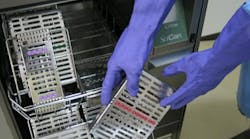Avoid disorganized instrument management
by Mary Govoni, CDA, RDA, RDH, MBA
In the nearly 20 years since instrument cassettes were introduced in dentistry, they remain one of the most effective safety and efficiency tools for dental practices. Investing in an instrument management system can significantly streamline not only instrument cleaning and sterilization, but also setup and breakdown of treatment rooms, and delivery of services. Organization is key in the efficient operation of any business. The nature of dentistry, with all the instruments and materials necessary for patient care, requires the high level of organization that instrument cassettes provide.
Implementation of an instrument management system begins with planning, which is critical to determining what instruments are needed and what sizes of cassettes are required to accommodate the instruments. I recommend listing all the types of procedures that are provided in the practice, both for the doctor(s) and hygienists. For each procedure, list the instruments required. When all the lists are completed, cross-reference them to determine what instruments are common to all procedures, e.g., a mirror, explorer, and perhaps a pair of cotton pliers. Then design the instrument setup for the most common procedures, such as composite and/or amalgam restorations, crown and bridge, scaling and root planing, etc.
With the exception of endo and oral surgery, I recommend that the doctor’s cassettes be standardized to include all instruments required for the most common procedures. This will require more instruments in each cassette, but it will save on the number of different types of cassettes needed. This ensures that the necessary instruments will always be where they are needed — at the clinician’s fingertips. Each clinician has different preferences, however, and may want cassettes specific to each procedure.
Steps for efficient management of instruments
Once the cassettes and setups are determined, the next step is determining how the instruments will be cleaned. Options include ultrasonic cleaners and dental instrument washers. The size of the practice and the size of the cassettes will be a determining factor. Other factors include cleaning cycle time, space requirements, and the volume of instruments that need to be processed daily. One important point is that even if a dental instrument washer is used, a small ultrasonic should also be used for the instruments that are not suitable for cleaning in a dental instrument washer (e.g., burs, mixed metals, carbon steel instruments).
There are similar considerations for sterilization of instruments in cassettes. The sterilizer must be large enough to accommodate the size and number of cassettes in a load, so as to decrease the time needed to reprocess the instruments. Manufacturers of cassettes and sterilizers are very helpful in facilitating this step. In fact, many offices may already be using the required sterilization equipment because it allows for a large volume of instruments to be processed at once, which saves time.
A common question I’m asked about cassettes is whether they need to be packaged for sterilization. The answer is yes, all instruments must be packaged prior to sterilization if they are not used immediately after removal from the sterilizer, according to the Centers for Disease Control and Prevention (CDC). The cassettes can be wrapped with special CSR wrap or placed in pouches. This again is a preference issue. Both are effective in maintaining sterility of the instruments in storage, provided that the wrap or pouch is not torn or compromised in any way.
When cassettes are used, setting up and breaking down the treatment room is very efficient. The assistant or hygienist simply needs to retrieve the appropriate cassette containing the instruments necessary for the procedure. Along with the instrument cassettes, I also recommend using procedure tubs to organize the additional disposable items and materials. The tubs should be organized according to procedures and may be duplicated in each treaatment room or stored in central sterilization. This significantly decreases setup time, since the assistant or hygienist doesn’t need to gather the supplies from separate containers or drawers each time. In its simplest form, setup requires a cassette and a tub.
At the end of the procedure, instruments are placed back in the slots in the cassette, which is closed for transport to the sterilization area. Once in the sterilization area, the entire cassette is placed into the instrument cleaner. There is no need to handle individual instruments, which is time consuming and increases the risk of injury to the clinician. Studies have shown that one of the most common work-related injuries to dental team members is puncturing the hands while processing contaminated instruments. The reason is twofold — most dental team members do not comply with the OSHA requirement for wearing puncture-resistant utility gloves when handling contaminated instruments, and if the instruments are loose (not in a cassette or container) the sharp, contaminated ends are exposed while the instruments are being handled. Placing instruments in cassettes prevents exposure to the sharp, contaminated ends of the instruments, which avoids percutaneous injuries.
Yet another advantage of using instrument cassettes is that protecting the working ends of the instruments during cleaning can prolong the life of the instruments. Since the instruments are held in slots in the cassettes, they don’t knock into other instruments or items in the ultrasonic cleaner. This preserves any special coatings and maintains the cutting edges longer.
Instrument management can be disorganized and labor intensive. On the other hand, it can be efficient, safe, and economical for dental practices. The key differences are good planning and using instrument cassettes.
Mary Govoni, CDA, RDA, RDH, MBA, is the owner of Clinical Dynamics, a consulting company based in Michigan. She is a member of the Organization for Safety, Asepsis and Prevention. She can be contacted at [email protected].
Past RDH Issues







